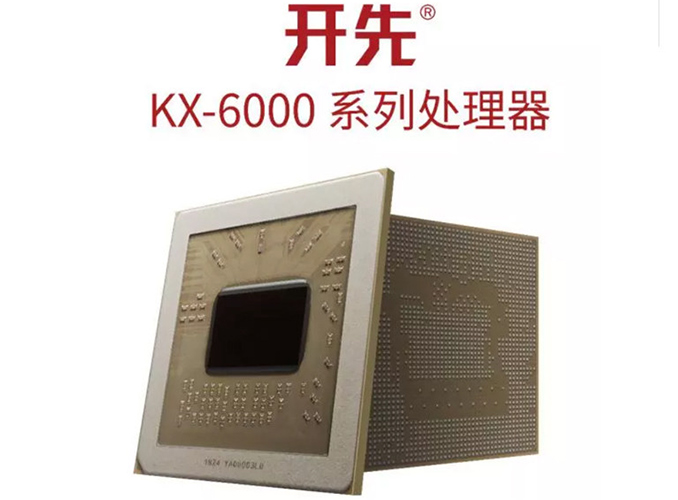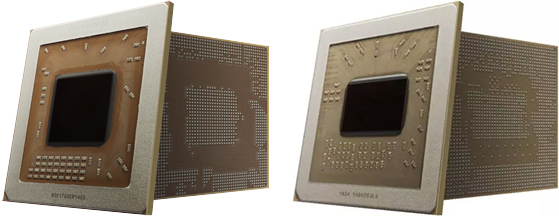Zhaoxin Displays x86-Compatible KaiXian KX-6000: 8 Cores, 3 GHz, 16 nm FinFET
by Anton Shilov on September 24, 2018 12:00 PM EST
Zhaoxin, a joint venture between Via Technologies and the Chinese government, this week for the first time displayed its upcoming x86-compatible CPU, the KaiXian KX-6000. The SoC features eight cores running at 3 GHz and increases performance over its predecessor by at least 50%.
The KaiXian KX-6000 is a successor to the KX-5000 CPU launched earlier this year. Both chips integrate eight-core x86-64 cores with 8 MB of L2 cache, a DirectX 11.1-capable iGPU with an up-to-date display controller, a dual-channel DDR4-3200 memory controller, contemporary I/O interfaces (PCIe, SATA, USB, etc), and so on. The key differences between the KaiXian KX-5000 and the KaiXian KX-6000 are frequencies and manufacturing technology: the former is produced using TSMC’s 28 nm fabrication process and runs at up to 2 GHz, whereas the latter is made using TSMC’s 16 nm technology and operates at up to 3 GHz. Zhaoxin claims that the Kaixian KX-6000 offers compute performance comparable to that of Intel’s 7th Generation Core i5 processor, which is a quad-core non-Hyper-Threaded CPU. Obviously, performance claims like that have to be verified, yet a 50% performance bump over the direct predecessor already seems beefy enough.
As the picture below shows, the thinner manufacturing process enabled Zhaoxin to make the KaiXian KX-6000 die smaller when compared to the predecessor, which will eventually shrink its manufacturing cost. Meanwhile, the two processors use different HFCBGA packaging and therefore cannot use the same motherboards. Meanwhile it is unknown whether the new KaiXian KX-6000 is compatible with Zhaoxin’s USB 3.1 Gen 2-capable ZX-200 chipset.
The Zhaoxin KaiXian KX-6000 relies on the LuJiaZui microarchitecture, which is an evolution of the WuDaoKou microarchitecture that powers the KX-5000 processor introduced in early 2018. Based on what we know today, the LuJiaZui is an x86-64-compatible superscalar, multi-issue, out-of-order microarchitecture that supports contemporary instruction sets extensions like SSE 4.2 and AVX along with virtualization and encryption technologies. Zhaoxin has yet to disclose differences between its LuJiaZui and WuDaoKou designs. Therefore, all we can do is speculate that since the microarchitectures are launched within one year from each other they are very similar, but the newer one has minor optimizations that, perhaps, enable higher clocks, improved caching, better memory support, etc.
Zhaoxin has not announced when it plans to start commercial shipments of its KaiXian KX-6000 processors, as right now it only displays its picture (which proves that it exists). Based on the previously published roadmap, we'd expect the CPU to hit the market in 2019, though when exactly is anyone's guess.
| Zhaoxin's Kaixian KX-5000 and KX-6000 CPUs | |||
| Kaixian KX-5000 WuDaoKou |
Kaixian KX-6000 LuJiaZui |
||
| Core Count | 4 - 8 | Up to 8 | |
| L2 Cache | 8 MB | 8 MB | |
| Frequency | Up to 2 GHz | Up to 3 GHz | |
| ISA | x86-64 | ||
| ISA Extensions | SSE 4.2, AVX | ? | |
| APIC | Yes | ||
| Virtualization | VMX technology, compatible with Intel's VT-X | ||
| Temperature monitoring, overheat protection | Yes | ||
| Power States | C1, C2, C3, C4, P-State | ? | |
| Hardware Encryption Engines | Advanced encryption engine (ACE), SHA-1, SHA-256, SM3/SM4, Randomizer | ? | |
| Security | TXT, EDB | ? | |
| iGPU | DirectX 11.1 feature set. Hardware-accelerated video encoding/decoding. Outputs: DP, eDP, HDMI, D-Sub Max Resolution: 4K Number of Displays: 3 |
? | |
| Packaging | x-ball HFCBGA 37.5 x 37.5 mm |
y-ball HFCBGA 37.5 x 37.5 mm |
|
| Process Technology | TSMC 28 nm | TSMC 16 nm FinFET | |
Related Reading:
- Cypress and Zhaoxin Have USB 3.1 Gen 2 USB Controllers
- China Calling: AMD Forms Joint Venture for x86 Server SoCs in China
- AMD Creates Quad Core Zen SoC with 24 Vega CUs for Chinese Consoles
Source: PC Watch











77 Comments
View All Comments
mode_13h - Tuesday, September 25, 2018 - link
What GPU is that? In-house design? Vivante? Imagination PowerVR?wrkingclass_hero - Tuesday, September 25, 2018 - link
Umm... am I the only one who noticed that their claims of 50% performance improvement matches up perfectly with their operating speed being exactly 50% greater. It's basically the same chip in a new process and clocked higher.defaultluser - Tuesday, September 25, 2018 - link
Right, it's just a clock bump.Also, the "same compute" comparison between this and a Core i5 quad core is very suspect. That leads me to believe that single-threaded performance is only slightly higher than the Via Nano this is likely based on. So eight years later, Via Tech is still running-in-place and trying to throw more cores at the problem.
At least the clock speed will make this about as fast as 1st-generation Bulldozer.
wumpus - Thursday, September 27, 2018 - link
Things really shouldn't line up that exactly between 28nm and 16nm, and I'd be shocked silly if they managed to somehow get the L1 cache to act with exactly 50% lower latency (there are other issues, but that one really stands out. Same with the L2 cache, but that is more easily tweaked and the differences aren't so big).Of course, it might be mostly small changes done by engineers, and a lot more transistors added by the Verilog compiler. That's my guess. Certainly nothing like Nahelm to Sandy Bridge, more like Sandy Bridge to Ivy Bridge (I had to go back that far since I don't think they've had a significantly bigger difference than Sandy-Ivy to this day).
jrs77 - Tuesday, September 25, 2018 - link
China is pushing really hard to have it's own CPUs and other necessary PC-hardware. They don't want to be reliant on the US as the rest of the world when things get bad.The US so far has bascially the rest of the world by it's balls with it's IT-products, so it's advisable to research, engineer and manufacture your own hardware. China takes a shortcut and simply steals all the technologies not giving a damn about patents as usual. And it's pretty much the sane thing to actually.
wurryno - Tuesday, September 25, 2018 - link
They didn't steal from Via Tech.Same as Via, AMD and IBM have both licensed their IP to Chinese companies. Zen and Power9 respectively